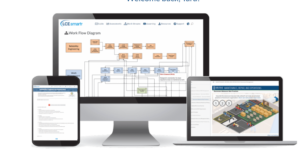Reducing Asset Life Cycle Cost by Designing for Reliability
How would you react if your equipment was hanging 200 feet in the air, extended over water? For most facility leaders this might make you feel uneasy, but for one international export team this is an everyday experience. For this premier potash exporter worldwide demand has steadily increased, so the group’s operations team was tasked with building a new export facility in the Pacific Northwest region of the United States. The facility will improve the efficiency of its shiploading operations with the addition of a new shiploader, enhanced control-system technology and an upgraded conveyance system that will yield shorter turnaround times.
To support the development of their facility, Life Cycle Engineering (LCE), industry professionals in reliability engineering and asset management, was contracted to assess the facility’s design to minimize the impact of future equipment failure and the corresponding repair time. In a lean maintenance environment the most effective way to reduce the life cycle cost of an asset is to minimize losses due to failure while still in the design phase, which reduces the recurring costs associated with the operation and maintenance activities over the asset’s life span.
Assessing the design to minimize future impact
LCE began by assessing the specification for reliability and maintainability issues. The results from the assessment spurred recommendations for design improvements with the goal of enhancing the future reliability of the shiploader.
One particular issue was the potential for high levels of fugitive dusting. The loading process, if not operated correctly, can create very heavy dusting, which impacts the equipment and can cause fugitive air emissions. The dust can create safety issues and equipment failure if not collected efficiently so LCE recommended an automatic system to control the height of the dust loading chute so the skirt would be touching the discharge pile. As it stood prior to the evaluation, the skirt wasn’t low enough to be in contact with the material pile and was causing more dust within the operating environment than normal. Lowering the skirt of the chute will help reduce the total amount of dust particles in the air as well as reduce the potential for corrosion and abrasion to all components.
The corrosion of steel structures and operating machines was a major concern even with the reduction of fugitive dusts. Relying on their naval experience, LCE experts recommended a protective coating system based on specifications used by the Naval Surface Treatment Center, which included surface preparation requirements, coating material and environment conditions.
Dust abrasion on moving equipment indicated the need for inspection protocols and predictive maintenance monitoring. The equipment was located in areas that were not readily accessible to maintenance personnel and the hazardous location of the equipment restricted routine predictive analysis by the technician. LCE also recommended that the facility install both thermal and vibration sensors that could be used to identify machine degradation before a failure occurred. The vibration sensors provide a frequency-based signature as well as an alarm in the control system based on amplitude. This recommendation will ultimately prevent their technician from being exposed to any hazardous location.
Gaining access to the machinery was very difficult so both teams worked together to develop a remote lubrication system. This has enabled maintenance supervisors to monitor each lube point to ensure the flow and pressures were running smoothly without having to physically maneuver into a potentially dangerous situation.
The last recommendation was centered on the shiploader, which uses a flexible cable and a reel assembly. Due to its close proximity to water and its elevation, lightning strikes have been known to happen to similar systems. To protect against this occurrence, a transient voltage surge suppression system with multiple layers of protection from medium to low voltage is now being installed based on LCE’s recommendation. The suppressors will be condition-monitored and alarmed to the PLC.
Ensuring reliability for your asset’s life cycle
Overall, LCE provided technical guidance with the goal of ensuring the shiploader operates at the highest levels of reliability and safety over the life of their equipment. Using reliability principles in the design phase to mitigate the potential risk of failure, the loader will achieve its goal for the project at a reduced cost over its life cycle.
For more information about improving operational and financial performance, please email LCE at info@LCE.com or visit www.LCE.com.
About LCE
Life Cycle Engineering (LCE) (www.LCE.com) provides consulting, engineering, applied technology and education solutions that deliver lasting results for private industry, the Department of Defense and other government organizations. The quality, expertise and dedication of our employees enable Life Cycle Engineering to serve as a trusted resource that helps people and organizations to achieve their full potential. Founded in 1976, LCE is headquartered in Charleston, South Carolina with offices across North America and experience around the globe.
Contact Us
Corporate Headquarters
Life Cycle Engineering
4360 Corporate Road
Charleston, SC 29405-7445
843.744.7110
info@LCE.com
















